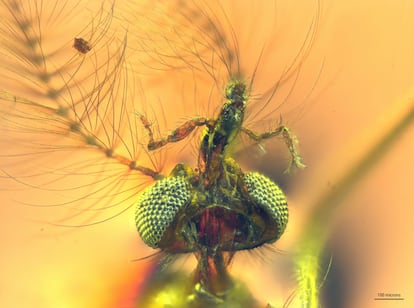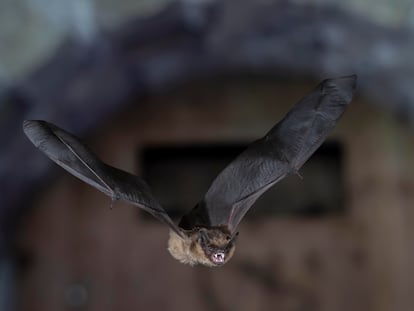Mosquitoes trapped in amber 130 million years ago show that males also sucked blood
The discovery of the insects has raised more questions about the history of the evolution of hematophagy

Some 130 million years ago, the place that is now Lebanon was very different. Back then, the land was located in the northeast of Gondwana, one of the two supercontinents that existed at the time, and was surrounded by the Tethys Sea. Unlike Lebanon’s current Mediterranean climate and landscape, the region was filled with tropical forests of auracarians and other conifers, such as the extinct Cheirolepidiaceae. The resin from one of these trees trapped two absent-minded mosquitoes and now, millions of years later, scientists have discovered that the insects sucked blood, something that only females do in current species. Why male mosquitoes stopped doing it remains a mystery.
Hematophagy is an evolutionary strategy that comes from ancient times. Evidence indicates that millions of years ago some insects that fed on nectar, molasses and plant sap switched to another fluid, the blood of animals. They had everything they needed to suck blood: a long proboscis, with its hollow stinger, sharp denticular (saw-shaped) jaws and piercing mouthparts. Hematophagous fleas, for example, belong to a lineage that separated from another family, the mecopterans, which were and continue to be nectarivores.
The biting insect par excellence is the mosquito, given its potential danger as a vector of disease. The 3,500 known mosquito species comprise the family Culicidae. But unlike other blood-sucking insects, only females suck blood. Females need the proteins in the bloodstream to lay a new clutch of eggs. In fact, a female mosquito begins her ovarian cycle after biting and ingesting blood. So if there is no blood, there is no new generation of mosquitoes. The males do not bite, and feed instead on nectar. In fact, a few years ago, researchers carried out an experiment in which male mosquitoes were made to lick blood. Within two or three days, they began to die as if they had been sprayed with insecticide. But it was not always like this.
The new species of culicid discovered by a group of researchers was trapped in amber about 130 million years ago. “These mosquitoes are the oldest that have been found and belong to a new subfamily that we created and that has a basal position among the Culicidae,” explains Dany Azar, an entomologist from the University of Lebanon, who was one of the authors of the study.
This new subfamily has been called Libanoculex intermedius. Two of the specimens are males and, intriguingly, they both have the features described above: a long proboscis, sharp denticular jaws and piercing mouthparts, as detailed in the scientific journal Current Biology.
“Mosquitoes belong to my collection,” Azar says. “I discovered this material about 15 years ago and at first I thought it belonged to the Chaoboridae [ghost mosquitoes, which do not bite], a sister group to the culicids. At that time, I didn’t have a good microscope,” he admits.
But during the Covid pandemic, he had time to review the specimens he had at home (and which are now stored in the Natural History Museum of the University of Lebanon) and order his collection. “I observed and prepared the specimens and was greatly surprised to see that they belong to the Culicidae. And my biggest surprise was seeing that they have teeth in their mouthparts, which we firmly believe were functional, so they fed on blood,” adds Azar, who is now working at the Nanjing Institute of Geology and Paleontology at the Chinese Academy of Sciences.

Dating back 130 million years, to the Lower Cretaceous, these two male mosquitoes are the oldest culicids to be found in the fossil record. There is evidence of ticks sucking the blood of dinosaurs about 100 million years ago. The new mosquitoes raise further questions about the evolution of hematophagy among insects. It’s an important topic. Beyond the annoying bites, different species of culicids transmit different diseases. The Aedes aegypti, for example, transmits viruses such as the Chikungunya, dengue and Zika, mosquitoes of the genus Culex spread the West Nile virus, and the Anopheles genus transmits malaria. Other diseases take advantage of these insects as vectors, such as equine encephalitis and La Crosse encephalitis.
Among the dipteran (two-winged) nematoceros (filamentous antennae) insects — which include flies and mosquitoes — there are other hematophagous groups, such as Psychodidae, also known as drain flies or sewer gnats. One of its genus, Lutzomyia, includes flies that transmit the Leishmania parasite. The Brachycera suborder also has species that feed on blood.
Other insect species fed on blood, then stopped doing it. This is the case of chironomids, which are so similar to mosquitoes that they are often mistakenly called that. These aquatic animals are one of the tools that paleontologists use to understand the climate of the past. Millions of years ago, they stopped being hematophagous. But unlike real mosquitoes, both the males and females stopped sucking blood.
André Nel, a researcher at the National Museum of Natural History at the Sorbonne University in Paris (France), is the co-author of the discovery published in Current Biology. When asked about why species such as chironomids lost the ability to assimilate blood, he acknowledges that the causes are not known. “The fact is that those hematophages became extinct, and we don’t know why. Maybe there were more resources for hematophagy during the early Cretaceous and then the resources decreased or competition between hematophagous flies led to the extinction of less adapted taxa,” he says.
In any case, Nel does not believe that this change in current culicids is an evolutionary regression. “Hematophagy is complicated because you need to be able to digest blood and blood microorganisms are ingested that must be neutralized, which is not so simple. Therefore, also maintaining hematophagous male mosquitoes could have been too costly [for the species] in terms of energy and adaptation. But these are just hypotheses. We weren’t there at the time.”
A few years ago, Enrique Peñalver, a paleontologist of the Geological and Mining Institute of Spain (IGME-CSIC), discovered the oldest tick in the world. The tick — found near the Spanish city of Santander — was 105 million years old. The paleontologist points out that fossils preserved in amber can be studied in greater detail and with greater care. For Peñalver, the mosquito discovery is significant because of its age. “It’s strange that such important and significant mosquitoes in the evolution of hematophagy were not detected before,” he says, adding that the study was carried out by “some of the best scientists in the world in paleoentomology.”
Sign up for our weekly newsletter to get more English-language news coverage from EL PAÍS USA Edition
Tu suscripción se está usando en otro dispositivo
¿Quieres añadir otro usuario a tu suscripción?
Si continúas leyendo en este dispositivo, no se podrá leer en el otro.
FlechaTu suscripción se está usando en otro dispositivo y solo puedes acceder a EL PAÍS desde un dispositivo a la vez.
Si quieres compartir tu cuenta, cambia tu suscripción a la modalidad Premium, así podrás añadir otro usuario. Cada uno accederá con su propia cuenta de email, lo que os permitirá personalizar vuestra experiencia en EL PAÍS.
¿Tienes una suscripción de empresa? Accede aquí para contratar más cuentas.
En el caso de no saber quién está usando tu cuenta, te recomendamos cambiar tu contraseña aquí.
Si decides continuar compartiendo tu cuenta, este mensaje se mostrará en tu dispositivo y en el de la otra persona que está usando tu cuenta de forma indefinida, afectando a tu experiencia de lectura. Puedes consultar aquí los términos y condiciones de la suscripción digital.
More information
Archived In
Últimas noticias
Maduro pleads not guilty before the federal court in New York: ‘I am still the president of Venezuela’
A new test can detect Alzheimer’s from a finger prick
UN team enters Sudanese city of El Fasher after paramilitary massacre: ‘It’s like a ghost town’
A recipe for resistance: Indigenous peoples politicize their struggles from the kitchen
Most viewed
- Gilles Lipovetsky: ‘If you want to live better and fall in love, take Prozac, don’t look to philosophy’
- Alain Aspect, Nobel laureate in physics: ‘Einstein was so smart that he would have had to recognize quantum entanglement’
- Alvin Hellerstein, a 92-year-old judge appointed by Bill Clinton, to preside over Maduro’s trial in New York
- Why oil has been at the center of Venezuela-US conflicts for decades
- Maduro’s downfall puts China’s relationship with Venezuela to the test











































